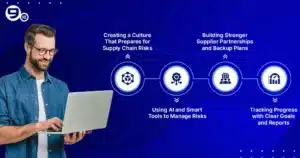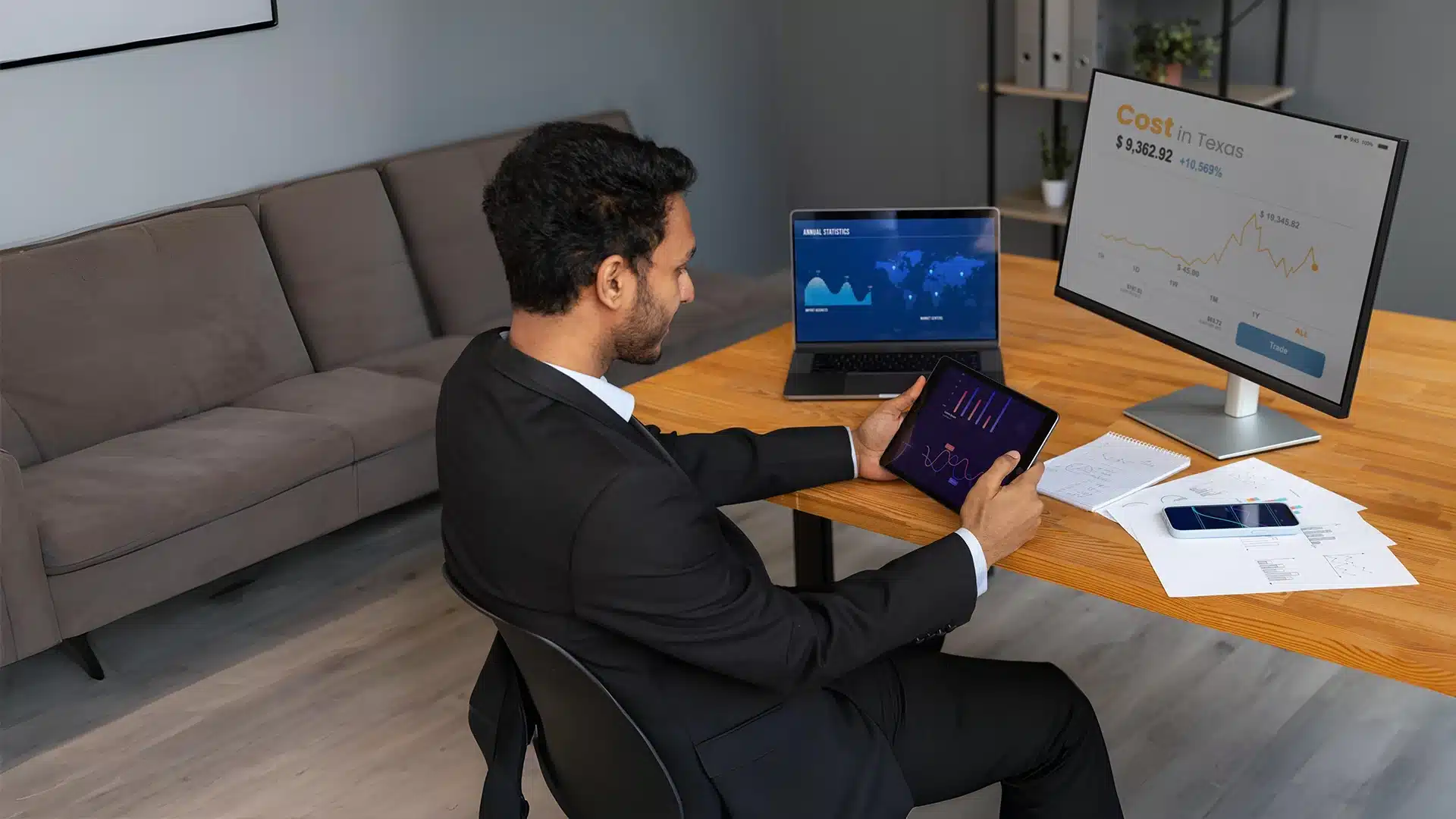How long could your company keep running smoothly if you find your main supplier has shut down overnight? Would you have the resilience to ride it out, or would you be forced into crisis mode? Supply chain breakdowns aren’t rare anymore. In fact, Statista reports that global businesses lost an average of 8% of their yearly revenue in just the past six months because of them.
It’s clear why supply chain risk management is a top priority in 2025. Companies everywhere are under pressure to build smarter and more resilient systems. This year alone, 82% of supply chain leaders say they’ve stepped up their investments in digital tools, new technology, and artificial intelligence to stay ahead. These figures highlight a straightforward reality that supply chain risk management is essential and not a luxury.
Read this blog ahead to break down the steps of the supply chain risk management process, along with best practices, real-world examples, and trends that will shape 2025.
What Is Supply Chain Risk Management (SCRM)?
Definition and Importance of SCRM
Supply chain risk management is the procedure of evaluating, reducing, and keeping an eye on risks that might interfere with operations down the line in the future. Causes of these risks can be natural disasters, supplier malfunctions, geopolitical conflicts, or cyberattacks.
No company can ever fully erase supply chain risks, and that’s okay. The real goal is to keep the business going while keeping the impact of the problems low. Partnering with a supply chain software development company can give businesses access to data tools, so that they can stay flexible even during tough times. At the end of the day, supply chain risk management is simply about changing surprise problems into challenges that you can handle easily.
-
Business Continuity: When unexpected disruptions hit, a strong supply chain risk management framework keeps things moving. Businesses can quickly make adjustments instead of coming to a pause.
-
Protection of Revenue: By predicting risks, companies can cut down on losses while protecting their profits and maintaining shareholder trust. Disruptions can lead to financial losses, which can be harmful to the companies.
-
Consumer Trust: Customers want consistency and reliability from a company. A risk management that is strong helps businesses deliver on their promises, build loyalty, and protect their brands.
-
Competitive advantage: In a market that is unpredictable, companies that are resilient always come out ahead. If they have the right supply chain risk management in place, they can adapt very quickly, grasp new opportunities and keep themselves ahead of the competition.
-
Regulatory Compliance: If a company has transparency, SCRM can assist it in adhering to legal requirements and avoiding fines. Non-compliance can often result in fines or recalls because global supply chains are being watched closely.
Key Challenges Businesses Face Without Risk Management
Without structured risk management, businesses often struggle with:
- Production delays caused by unforeseen supplier failures
- Cost increases brought on by abrupt shifts in the price of raw materials
- Damage to one’s reputation when client demands are not fulfilled
- Regulatory sanctions for noncompliance
Businesses encounter delays that slow down production and result in delivery backlogs, especially when a supplier stops operations or experiences disruptions. Functions like order fulfillment and customer satisfaction are directly impacted by this.
Businesses are susceptible to changes in the price of raw materials. An increase in price can force companies to raise product prices, which could reduce profit margins.
Years of building a brand’s image can be destroyed with a single setback. Therefore, negative reviews are avoided to prevent disgruntled customers and losing long-term loyalty.
Heavy fines, operational limitations, and damage to reputation can arise from missing compliance deadlines or failing audits. Supply chains frequently function within several jurisdictions with strict laws.
Why SCRM Is a Competitive Advantage in 2025
By 2025, companies that implement a systematic supply chain risk management process will have a significant competitive advantage, since being visible and proactive will be required. Only 6% of businesses say they have complete supply chain visibility, while most only have limited or partial visibility, according to Statista. Since businesses are unable to identify the risks, most of them are working at a disadvantage as of now.
Need a custom supply chain solution?
Talk to our Experts
Request A Free Quote
What makes it challenging is that over 62% of businesses admit that they have little control over their supply chains, as per stats. Less than one in five businesses (17%) claim to have more visibility beyond their direct suppliers.
Such gaps result in increased expenses, weakening of customer trust, and very slow crisis response time. The company that has a strong SCRM can adapt quickly and run more smoothly than ever. By investing in digital tools, companies can achieve great benefits. During the time of any disruption, companies with a good SCRM perform better.
Why the Supply Chain Risk Management Process Matters Today
How Global Events Showed Weak Points in Supply Chains
What if your business has been working on the largest product launch of the year for months? Retailers are waiting to fill shelves, marketing campaigns are active, and demand is extremely high. But all of a sudden, the raw materials you depend on are stranded at a port that has been blocked, and there is no indication when they will be released.
Take a look…
How Much Does It Cost to Develop a Supply Chain Software?
In a matter of days, your brand’s reputation suffers, orders begin to pile up, and customers begin to voice their displeasure on social media. Doesn’t that sound stressful? Thousands of businesses encountered precisely this during recent world events.
The first wake-up call was the COVID-19 pandemic. Businesses were left scrambling to source even basic components as factories closed and borders closed. Businesses were left with empty warehouses all of a sudden during such a time. Next up, during the conflict between Russia and Ukraine, global supply chains were strained due to a loss of agricultural exports and commodities like metals.
The 2021 blockage of the Suez Canal cannot be overlooked. For days, a single ship stuck sideways stopped almost 12% of the world’s trade. Imagine depending on that route for your shipments; businesses that were unable to deliver on time would have lost millions of dollars.
The fact that even Fortune 500 giants were not immune is what matters here. Automakers stopped production, tech companies postponed product launches, and retailers saw their shelves run dry. Smaller companies are even more at risk if billion-dollar companies can make mistakes.
From these incidents, it is quite clear that global supply chains have become more vulnerable than many companies realized. Without a robust supply chain risk management process, businesses are vulnerable to uncontrollable circumstances. The lesson? The question is not whether disruptions will occur, but rather when they will occur and if you will be ready to deal with them.
The Impact of Poor Risk Management on Business Performance
Cost escalates quickly when risks are not managed:
-
Revenue Losses: As per the records of McKinsey, during major supply disruptions, companies lose an average of 42% of annual profits. Lost revenue often creates an impact on shareholders’ confidence and growth potential in the future.
-
Operational Delays: Often, even a single weak link, like a supplier shutdown, creates tons of backlog. The effects of these delays can be felt across the chain. It leads to missed deadlines, higher costs in logistics, and frustrated customers.
-
Lost Market Share: During such a time, there is a risk of losing customers. More often than ever, they move to the competitors who are delivering consistently. It leads to losing customer loyalty, which is pretty hard to earn back, sometimes even impossible.
-
Reputation Damage: Inconsistency in deliveries could create a bad reputation among the customers. In a digital world, a single failure can spark negativity for the company.
-
Regulatory and Compliance Risks: Poor oversight may create trouble with compliance requirements. It could result in legal penalties and sometimes even product recalls. Such problems could harm trust with the partners, regulators, and consumers.
Key Stats That Prove the Importance of SCRM
Relevant Statista & Related Data
- The global supply chain management market was listed and valued at-USD 15.85 billion(2020), and the supply chain management software market is similarly large.
-
According to Statista, a 100-day disruption in production and distribution for aerospace companies can cause a severe drop in EBITDA (earnings before interest, taxes, depreciation, and amortization).
-
As per the 2024 Statista survey, security measures in supply chains include multi-factor authentication, data encryption, and security awareness training to take care against breaches.
What These Stats Tell Us
These data points reinforce that SCRM is a business necessity, not an option. Here’s why:
- Significant Financial Risk
Long-term disruption losses (such as a 100-day stoppage) highlight how brittle EBITDA can be. Persistent supply chain failures can cause a sharp decline in earnings for businesses in sectors like aerospace. Strong planning, varied sourcing, inventory buffers, and dynamic supply chain visibility are all necessary for this type of financial risk.
- Expanding Market and Increasing Investment
Over the coming years, the market for SCRM tools is expected to double in size. The fact that the base amount is close to USD 4.5 billion in 2025 and will reach approximately USD 9.2 billion by 2030 shows how much organizations are reacting by spending money on analytics, risk monitoring, compliance tools, scenario planning, and other things. This implies that businesses that don’t invest run the risk of falling behind in terms of competitiveness and resilience.
Imperatives in Technology and Security
SCRM is as much about digital trust and system resilience as it is about physical or logistics continuity, as evidenced by the fact that many organizations are implementing advanced security measures (encryption, multi-factor authentication), given that cyber risk, data breaches, and other digital exposures are becoming just as dangerous as physical disruptions.
Reputation and Trust
Reliability and transparency are becoming more and more linked to how partners and customers perceive businesses, even beyond the immediate financials. The reputational harm can spread and cost more in lost opportunities, loyalty, or market share if disruptions result in supply shortages, mistakes, or a lack of confidence in the integrity of the supply chain.
The Five Key Stages of the Supply Chain Risk Management Process
Step 1: Risk Assessment (Vulnerability Mapping)
Finding possible disruption sites is the first stage in the supply chain risk management process. Risks can be of two kinds: sometimes they can be external, like supplier bankruptcy or geopolitical conflicts, and sometimes they can be internal
Businesses often make a risk map that depicts every phase of the supply chain for the company. From sourcing out the raw material to the last-mile delivery, it maps out the vulnerabilities efficiently.
Pro Tip: To make sure there are no blind spots, regularly perform scenario analysis and supplier audits. This foundation guarantees that you are aware of your weaknesses before they become serious issues.
Step 2: Prioritization and Risk Assessment
Analysing the likelihood and impact of the risks is next after it being identified. Even the slightest delay in packaging could result in a serious cyberattack on logistics systems. Therefore, all risks cannot be treated equally.
Companies can sort out risks into low, medium, and high using a risk matrix. This aids the leaders in effectively allocating resources and prioritizing the most suspicious threats.
For example, “low probability, low impact” risks can be tracked, but “high probability, high impact” risks, such as shortages of materials, need to be taken care of at the exact moment. It can be considered as a risk triage, similar to how doctors treat their patients.
Stage 3: Planning for Mitigation and Strategy Development
Then the organization should prepare a mitigation strategy to lower exposure after assessing the risks. These tactics could involve investing in automation to lessen the reliance over manual procedures. Contractual provisions with suppliers serve as an additional safeguard. It is critical to create plans that are both scalable and economical.
Organizations must develop mitigation strategies to lower exposure after evaluating risks. These tactics could involve investing in automation to lessen reliance on manual procedures, diversifying suppliers, or developing backup logistics routes. Contractual provisions with suppliers and insurance policies serve as additional safeguards. It’s critical to create plans that are both scalable and economical.
Pro Tip: Always match at least one mitigation strategy with each risk that has been identified. For example, prepare a backup supplier in case reliance on a single source is an issue. At this point, risk awareness is converted into practical defenses.
Stage 4: System Implementation and Monitoring
Strategies need to be carried out properly. The employee training and technological integration are the main goals of this stage. Real-time remarks about supplier delays, geopolitical shifts, or traffic jams can be obtained through platforms that are powered by AI. Risk management is made more transparent by software that assesses key performance indicators such as lead time consistency. Frequent training often guarantees that staff members are capable of reacting to problems properly. The importance of monitoring can be characterized as an early warning system. This phase connects execution and strategy.
Stage 5: Ongoing Evaluation and Enhancement
Risk management is a continuous process of improvement. Companies need to test responses and plan against the threats, and evaluatethe performance of the supplier. The supply chain risk management process needs to be updated with the brand-new technology of the world. Companies can stay up to date by conducting quarterly reviews and examining lessons learned from previous disruptions.
Pro Tip: Approach risk management the same way you approach updating your phone’s software. Each update fortifies defenses against emerging threats. Businesses can make sure that their supply chains are robust, flexible, and prepared for whatever the future holds by adopting continuous improvement.
Best Practices for Effective Supply Chain Risk Management
Creating a Culture That Prepares for Supply Chain Risks
The best results from supply chain risk management come from integrating it into business culture. When disruptions occur, teams that practice response drills and cross-departmental training are much more confident. By promoting proactive planning as opposed to reactive scurrying, leadership plays a significant role. To instill resiliency in the culture:
- Plan frequent risk drills and workshops.
- Teams should be trained across functions to coordinate more quickly.
- Make resilience a top priority for your leadership.
Using AI and Smart Tools to Manage Risks
Imagine a situation where a foreign supplier exhibits unexpected financial instability. AI-powered solutions identify the issue early rather than too late, allowing you to change suppliers and prevent interruption. Risk is transformed into foresight by smart tools. Businesses can:
- Use predictive analytics to plan your demand and inventory.
- Utilize AI to predict delays and track supplier health.
- Install dashboards in real time for immediate visibility.
Building Stronger Supplier Partnerships and Backup Plans
Businesses that had solid relationships with suppliers and other partners continued to operate when the Suez Canal was blocked, while others were forced to wait. That is the strength of backups and trust. To increase resilience:
- Keep in regular contact with your suppliers.
- Work together on shared data and transparency.
- Maintain backup suppliers on hand.
Tracking Progress with Clear Goals and Reports
Efficient reporting guarantees that your tactics are more than just theory; they are quantifiable advancements. KPIs encourage accountability and make success visible. Companies ought to:
- Monitor lead time accuracy, recovery speed, and supplier dependability.
- Make risk data available to leaders by using dashboards.
- Regularly review reports to improve tactics.
Case Study: Real-World Example of Risk Management Success
How Company Toyota Reduced Supply Chain Risk
As the COVID-19 pandemic spread around the world, the automotive sector faced many challenges due to the semiconductor chip shortage. Like many car manufacturers, Toyota saw its production lines at risk when essential chip suppliers could not meet demand or communicate effectively.
Toyota responded with a hands-on approach. They used a multi-step supply chain risk management process to lessen their exposure and maintain operations. Their measures reflect the same pattern as your SCRM stages:
-
Supplier Diversification and Buffer Sourcing: Toyota expanded its supplier base beyond its usual channels and qualified additional suppliers in different regions. It built buffer inventories for critical chips to protect against sudden disruptions.
-
Real-time Monitoring and Visibility Tools: The company improved its supply chain transparency by investing in systems to monitor supplier health, lead times, and logistics delays, such as transport issues or port congestion.
-
Supply Agreements and Contract Flexibility: Toyota renegotiated contracts to add clauses for risk events, such as delays and minimum supply guarantees. They also set up secondary sourcing agreements so that if one supplier faltered, another could step in.
-
Reducing Recovery Time: With backup suppliers and better visibility, Toyota could respond more quickly to disruptions. When one supplier in East Asia faced shutdowns, Toyota shifted orders to alternate suppliers in other regions and tapped into its buffer stocks, avoiding a complete halt in production.
Outcomes
- Toyota avoided large-scale shutdowns that many other companies in the automotive industry encountered during the chip crisis.
- They maintained higher production continuity than many competitors. This helped them preserve market share and kept delivery dates more reliable.
- The company’s reputation for reliability grew during this time, as customers experienced fewer delays compared to rivals.
Future Trends in Supply Chain Risk Management
1. Predicting Supply Chain Risks Using AI and Data
Predictive analytics can allow businesses to see issues before they even happen, which can be a game-changing move. Moreover, AI will help in tracking patterns that are in demand, weather, or even suppliers’ behaviour, which could help companies to act before any crisis. Such an approach would transform risk into foresight.
2. The Enhancement of Supply Chain Transparency through Blockchain
Because blockchain creates a proof record of every transaction, it improves accountability in global supply chains. Businesses and consumers can trust the source of products because it guarantees that the transaction can be tracked from beginning to end. Such acts give any business credibility and confidence.
3. Use Sustainable Practices to Manage Supply Chain Risks
By adopting sustainable supply chain practices, like using eco-friendly packaging, businesses can lower their costs over time. Companies can also lower environmental risks and better meet customer expectations by concentrating on green logistics.
Conclusion: Building a Resilient Supply Chain in 2025
The goal of the Supply Chain Risk Management process is to identify, evaluate, plan, implement, and continuously improve risk management strategies. Businesses that put a high priority on SCRM become more resilient, allowing them to endure setbacks and continue operating efficiently.
Businesses should first map possible risks throughout their supply chain before incorporating AI and digital tools for monitoring and insights in order to create a solid SCRM strategy. It’s equally critical to fortify supplier networks with alliances and dependable contingencies. Strategies remain effective in changing circumstances with the support of frequent reviews and improvements.
Need a custom supply chain solution?
Talk to our Experts
Request A Free Quote
Organizations that remain proactive and embrace innovation will gain a competitive edge and guarantee long-term supply chain stability, whether through the development of logistics software or the adoption of sophisticated automation tools.
FAQs
Q1. What are the 5 key steps in managing supply chain risk management?
The five steps include Risk Identification, Risk Assessment, Strategy Development, Implementation, and Continuous Improvement. Together, they create a cycle that helps businesses stay prepared, resilient, and adaptable against disruptions.
Q2. What is the supply chain risk management process?
It’s a structured approach where companies identify potential risks, assess their impact, create mitigation strategies, and monitor them continuously. The main aim is to minimize disruptions and ensure smooth, reliable operations.
Q3. What are the 5 stages of risk management?
The five stages are Identify, Assess, Develop Strategy, Implement, and Review. Each stage builds on the previous one, ensuring risks are not only addressed but also monitored for long-term improvement.
Q4. What are the main types of supply chain risks?
Key risks include supplier failures, cyber threats, natural disasters, geopolitical issues, and compliance challenges. Each can disrupt operations if not managed with a strong risk management process.
Great Together!












